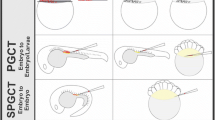Abstract
The gonad is an essential organ for generating sperm and ova in vertebrates. This review describes several pilot studies on gonad gene manipulation and development in fish. With antisense RNA techniques, we suppressed the gonad development, and thus the fertility, of an antisense gonadotropin-releasing hormone (sGnRH) transgenic common carp. Then, using a tissue-specific exogenous gene excision strategy with sexual compensation, we knocked out the gonad-specific transgene. Under the control of the rainbow trout protamine promoter, the transgenic fish expressed the reporter gene eGFP specifically in the spermary. These results indicate that the fish gonad is a new model organ that can improve contemporary biotechnology experiments. Herein we discuss the potential of fish gonad manipulation for resolving important biosafety problems regarding transgenic fish generation and producing the new transgenic animal bioreactor.
Similar content being viewed by others
References
Zhu, Z., Li, G., He, L. et al., Novel gene transfer into the fertilized eggs of goldfish (Carassius auratus L. 1758). Z. Angew. Ichthyol., 1985, 1: 31–34.
Wang, R., Zhang, P., Gong, Z. et al., Expression of the antifreeze protein gene in transgenic goldfish (Carassius auratus) and its implication in cold adaptation, Mol. Mar. Biol. Biotechnol., 1995, 4(1): 20–26.
Maclean, N., Laight, R. J., Transgenic fish: an evaluation of benefits and risks, Fish and Fisheries, 2000, 1: 146–172.
Nam, Y. K., Noh, J. K., Cho, Y. S. et al., Dramatically accelerated growth and extraordinary gigantism of transgenic mud loach, Misgurnus mizolepis, Transgenic Res., 2001, 10(4): 353–362.
Zhong, J., Wang, Y., Zhu, Z., Introduction of the human lactoferrin gene into grass carp (Ctenopharyngodon idellus) to increase resistance against GCH virus, Aquaculture, 2002, 214: 93–101.
Mao, W., Wang, Y., Wang, W. et al., Enhanced resistance to Aeromonas hydrophila infection and enhanced phagocytic activities in human lactoferrin-transgenic grass carp (Ctenopharyngodon idellus), Aquaculture, 2004, 242: 93–103.
Rudolph, N. S., Biopharmaccutical production in transgenic livestock, Trends Biotechnol., 1999, 17, 367–374.
Morita, T., Yoshizaki, G., Kobayashi, M. et al., Fish eggs as bioreactors: The production of bioactive luteinizing hormone in transgenic trout embryos, Transgenic Res., 2004, 13: 551–557.
Hwang, G., Müller, F., Rahman, M. et al., Fish as Bioreactors: Transgene expression of human coagulation factor VII in fish embryos, Mar. Biotechnol., 2004, 6: 485–492.
Zhu, Z., Xu, K., Xie, Y. et al., A model of transgenic fish, Scientia Sinica B (in Chinese), 1989, 2: 147–155.
Wang, Y., Hu, W., Wu, G. et al., Genetic analysis of “All-fish” growth hormone gene transferred Yellow River carp (Cyprinus carpio. L) and its F1 generation, Chinese Science Bulletin, 2001, 46: 1174–1177.
Zhang, F., Wang, Y., Hu, W. et al., Physiological and pathological analysis of mice fed with “all-fish” gene transferred Yellow River carp, High Technol. Lett. (in Chinese), 2000, 7: 12–17.
Knibb, W., Risk from genetically engineered and modified marine fish, Transgenic Res., 1997, 6: 59–67.
Muir, W. M., Howard, R. D., Possible ecological risks of transgenic organism release when transgenes affect mating success: Sexual selection and the Trojan gene hypothesis, Proc. Natl. Acad. Sci. USA., 1999, 96(24): 13853–13856.
Muir, W. M., Howard, R. D., Assessment of possible ecological risks and hazards of transgenic fish with implications for other sexually reproducing organisms, Transgenic Res., 2002, 1(2):101–114.
Stokstad, E., Engineered fish: Friend or foe of the environment? Science, 2002, 297: 1797–1798.
Gage, M. J. G., Stockly, P., Parker, G. A., Effects of alternative male mating strategies on characteristics of sperm production in the Atlantic salmon (Salmo salar): Theoretical and empirical investigations. Philos. Trans. R. Soc. Lond. Ser. B, 1996, 350: 391–399.
Suresh, A. V., Sreenan, R. J., Biochemical and morphological correlates of growth in diploid and triploid rainbow trout, J. Fish Biol., 1998, 52: 588–599.
Razak, S. A., Hwang, G., Rahman, M. A. et al., Growth performance and gonadal development of growth enhanced transgenic tilapia Oreochromis niloticus following heat-shock-induced triploidy, Mar. Biotechnol., 1999, 1: 533–544.
Liu, S. J., Liu, Y., Zhou, G. et al., The formation of tetraploid stocks of red crucian carp × common carp hybrids as an effect of interspecific hybridization, Aquaculture, 2001, 192(3-4): 171–186.
Sun, Y., Liu, S., Zhang, C. et al., The chromosome number and gonadal structure of f9-f11 allotetraploid crucian carp, Acta Genetica Sinica (in Chinese), 2003, 30(5): 414–418.
Fernald, R. D., White, R. B., Gonadotropin-releasing hormone genes: Phylogeny, structure and functions, Front. Neuroendocrinol., 1999, 20: 224–240.
Mason, A. J., Hayflick, J. S., Zoeller, R. T. et al., A deletion truncating the gonadotropin-releasing hormone gene is responsible for hypogonadism in the hpg mouse, Science, 1986, 234: 1366–1371.
Mason, A. J., Pitts, S. L., Nikolics, K. et al., The hypogonadal mouse: Reproductive functions restored by gene therapy, Science, 1986, 234: 1372–1378.
Singh, J., O’Neill, C., Handelsman, D. J., Induction of spermatiogenesis by androgens in gonadotropin-deficient (hpg) mice, Endocrinology, 1995, 136: 5311–5321.
Oeller, P. W., Lu, M. W., Tanlor, P. L. et al., Reversible inhibition of tomato fruit senescence by antisense RNA. Science, 1991, 254: 437–439.
Uzbekova, S., Chyb, J., Ferriere, F. et al., Transgenic rainbow trout expressed sGnRH-antisense RNA under the control of sGnRH promoter of Atlantic salmon, J. Mol. Endocrinol., 2000, 25: 337–350.
Li, S., Hu, W., Wang, Y. et al., Cloning and expression analysis in mature individuals of two chicken type-II GnRH (cGnRH-II) genes in common carp (Cyprinus carpio), Science in China, Ser. C, 2004, 47(4): 349–358.
Author information
Authors and Affiliations
About this article
Cite this article
Hu, W., Wang, Y. & Zhu, Z. A perspective on fish gonad manipulation for biotechnical applications. Chin. Sci. Bull. 51, 1–6 (2006). https://doi.org/10.1007/s11434-005-1055-3
Issue Date:
DOI: https://doi.org/10.1007/s11434-005-1055-3




